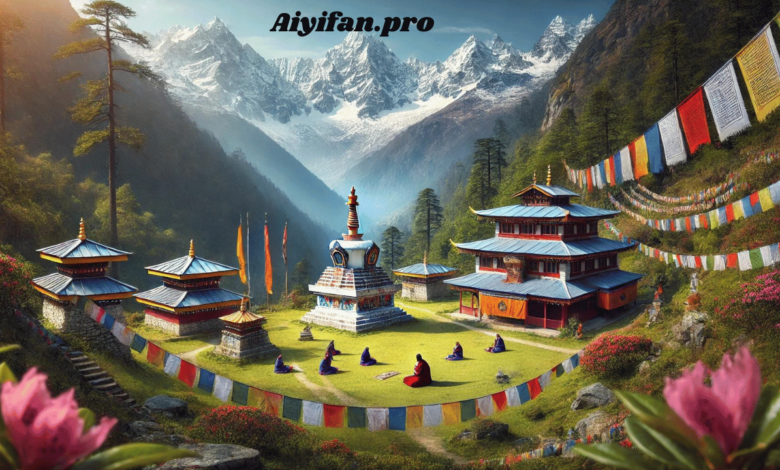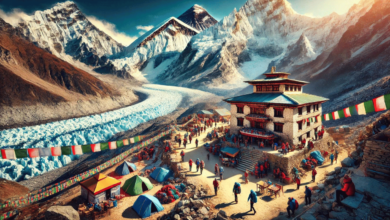Discovering the Himalayan Resting Place: A Sanctuary of Serenity and Spirituality

The Himalayan Resting Place, nestled high in the majestic Himalayan mountains, is a destination that transcends mere geography. It is a sanctuary where nature’s grandeur meets profound spirituality, offering travellers an experience that is as enriching for the soul as it is breathtaking for the eyes. This article explores the Himalayan Resting Place’s multifaceted beauty and cultural significance, guiding you through its spiritual heritage, natural wonders, adventure opportunities, and the importance of sustainable tourism in this fragile ecosystem.
The Spiritual Significance of the Himalayan Resting Place
A Sacred Retreat in the Himalayas
The Himalayas have long been revered as a sacred space where the physical world and the divine coexist harmoniously. The Himalayan Resting Place, often called “Serenity Summit,” is one such site. This sacred haven has attracted pilgrims, seekers, and spiritual leaders for centuries, all drawn by the region’s promise of peace and enlightenment.
Monasteries dot the landscape, each a testament to the area’s enduring spiritual traditions. These monasteries are not just places of worship but also learning centres where ancient teachings are passed down through generations. The silence that pervades these sacred spaces is profound, interrupted only by the rustle of prayer flags or the soft chanting of monks. Visitors often describe the experience as transformative, a journey inward as much as outward.
Meditation Meadows and Prayer Stupas
Among the many spiritual attractions at the Himalayan Resting Place are the Meditation Meadows and Prayer Stupas. The Meditation Meadows, encircled by rhododendron forests, provide an ideal setting for deep introspection. The natural beauty of the meadows, combined with the tranquillity of the environment, creates a perfect backdrop for meditation and spiritual reflection.
Prayer Stupas, scattered throughout the region, serve as focal points for meditation and prayer. Each stupa is adorned with intricate carvings and vibrant prayer flags, which flutter in the mountain breeze, symbolizing the spreading of peace and compassion. These stupas are not merely religious structures; they are embodiments of the Himalayan belief in the interconnectedness of all life.
Cultural Heritage and Traditions
A Tapestry of Stories and Rituals
The Himalayan Resting Place is steeped in cultural heritage. It is a living tapestry woven with stories of devotion, resilience, and the timeless connection between humanity and nature. The rituals and traditions observed here are deeply rooted in the local culture, reflecting a way of life that has remained unchanged for centuries.
One of the most fascinating aspects of visiting the Himalayan Resting Place is the opportunity to witness these age-old rituals firsthand. Whether it’s the lighting of butter lamps at a monastery, the spinning of prayer wheels, or the annual festivals that bring communities together, these traditions offer a window into the soul of the Himalayas.
Artisanal Treasures and Local Cuisine
No visit to the Himalayan Resting Place is complete without exploring the local markets, where you can find a treasure trove of artisanal crafts. Handmade textiles, intricate jewellery, and traditional Thangka paintings are just some items that showcase the skill and artistry of the Himalayan people. These crafts are more than just souvenirs; they reflect the region’s cultural richness and are a way to support local artisans.
The cuisine of the Himalayas is equally diverse and delightful. Traditional dishes like momos (dumplings), thukpa (noodle soup), and yak butter tea offer a taste of the mountains. Each dish is prepared with locally sourced ingredients, reflecting the region’s unique culinary traditions. Eating in the Himalayas is not just about sustenance; it’s a cultural experience that connects you with the land and its people.
Natural Beauty and Biodiversity
A Land of Majestic Landscapes
The natural beauty of the Himalayan Resting Place is unparalleled. From snow-capped peaks that touch the sky to verdant valleys teeming with life, the landscape is a feast for the senses. The Himalayas stretch across five countries—India, Nepal, Bhutan, China, and Pakistan—offering unique vistas and experiences.
One of the most striking features of the Himalayan Resting Place is its biodiversity. The region is home to various flora and fauna, including rare species such as the snow leopard, red panda, and Himalayan blue poppy. The diverse ecosystems range from alpine meadows to subtropical forests, each supporting a different array of life. The Himalayan Resting Place is nothing short of a paradisefor nature lovers.
Popular Destinations within the Himalayas
While the entire Himalayan region is breathtaking, certain areas stand out for their natural beauty and cultural significance. Leh-Ladakh, known for its stark landscapes and Buddhist monasteries, offers a unique blend of adventure and spirituality. With its charming hill stations like Shimla and Manali, Himachal Pradesh is another popular destination. Uttarakhand, home to sacred sites such as Haridwar and Rishikesh, is known for its spiritual significance and natural beauty. Meanwhile, Nepal, famous for Mount Everest, and Bhutan, the land of the Thunder Dragon, offers rich cultural experiences and stunning landscapes.
Adventure and Wellness in the Himalayas
Trekking and Outdoor Activities
For those seeking adventure, the Himalayan Resting Place offers some of the best trekking routes in the world. The Annapurna Circuit, Everest Base Camp, and Markha Valley Trek are just a few options for trekking enthusiasts. These treks offer physical challenges and spiritual rewards as you traverse some of Earth’s most remote and beautiful landscapes.
In addition to trekking, the Himalayas offer a range of other outdoor activities, including white-water rafting, paragliding, and skiing. Whether you’re an experienced adventurer or a beginner, there’s something for everyone in the Himalayas.
Health and Wellness Retreats
The serene environment of the Himalayas makes it an ideal destination for health and wellness retreats. Yoga and meditation centres, particularly in Rishikesh, offer programs to rejuvenate the mind and body. These retreats are often located in remote areas, where the only sounds are those of nature, allowing for deep relaxation and introspection. The combination of physical activity, spiritual practice, and natural beauty makes the Himalayan Resting Place a perfect destination for those seeking a holistic approach to wellness.
The Importance of Sustainable Tourism
Preserving the Natural and Cultural Heritage
As the popularity of the Himalayan Resting Place continues to grow, so does the need for sustainable tourism practices. The Himalayas’ fragile ecosystem is vulnerable to mass tourism’s impacts, including deforestation, pollution, and cultural erosion. Visitors and local communities must adopt eco-friendly practices to preserve the region’s natural beauty and cultural heritage.
Travelers are encouraged to minimize their environmental footprint by using biodegradable products, reducing waste, and supporting local businesses. Staying in eco-friendly accommodations, participating in community-based tourism, and respecting local customs are just a few ways to contribute to the sustainability of the Himalayan Resting Place. By making mindful choices, we can help ensure this sacred region remains a sanctuary for future generations.
Conclusion
The Himalayan Resting Place is more than just a destination; it is a soul journey. Whether you are drawn to its spiritual heritage, natural beauty, adventure opportunities, or the promise of peace and introspection, the Himalayas offer a profound and unforgettable experience. As you explore this majestic region, remember to tread lightly, respecting the delicate balance of nature and culture that makes the Himalayan Resting Place a true sanctuary for all who visit.
You May Also Read: The Hotel Concierge Sheanimale: Unveiling the Role in Modern Hospitality




